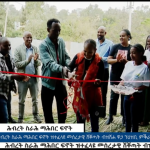SISAL-is a perennial plant with a type of leave tissue that contains strong flexible
fibber, and it is the most important of the group of hard fibbers, and a commercial
crop. In 1893, a far-sighted German agronomist took samples of the succulent plant
Agave sisalana (sisal) out their native Yucatan peninsula in Mexico and took them to
Germany’s East African colony of Tanganyika. The hardy agave, which produces
some of nature’s longest and strongest plant fibers, thrived in the country’s hot
tropical climate and by the early 20th century was producing the ropes of the German
naval fleet.
SISAL can be cultivated in most soil types except heavy soils (verti sol), has low
tolerance to water logging, and saline soil conditions. The plant produces best with
annual rainfall of 500 mm and higher, it can also survive in areas with less rainfall
(Erratic rainfall). Areas in Tigrai like Erob, Fatsi, Agulae to Mai Kekhden, Eastern
parts of Mai Keyah to Adigudom, Eastern parts of Wojerat, and others will be
excluded from this program or treated with proper water harvesting structures.
FIBER-is a thread of filament from which a plant or animal tissue, mineral substance
or textile is formed. Here we are interested in plant fibbers. Plant fibber can be
harvested from Sisal, Kenaf, Jute, False banana, Coir & others. In this paper we
focus on sisal fibber.
In the countries of production sisal has about 50 leaves, each weighing up to 1 kg.
The average annual yield in a commercial farm is about 2.25 to 4.0 tones fibber/ha,
with a plant population of 5,000 plants/Ha.
Global production of Sisal fibber is 213,304 to 1,100,000 Tons/year. And global sisal
market is USD 1,299.3/Ton, and in Kenya Market Sh175,144.9 (1,594.9 USD)/Ton in
2022.
The top NINE sisal producing countries in the world are: from Africa (Tanzania,
Kenya, Madagascar, Mozambique & Angola), & from the rest of the world: (Brazil,
China, Mexico, & Haiti ) respectively according to the amount they produce.
The sisal fiber is traditionally used for rope and twine, and has many other uses,
including paper, cloth, footwear, hats, bags, carpets, geotextiles, and dartboards. It is
also used as fiber reinforcements for composite fiber glass, rubber, and concrete
products.
In Tigrai Sisals are planted and left to grow by themselves, without weeding, hoeing,
fencing or other cultivation, which is proven that, there is immense potential to grow
sisal on the hillsides of Tigrai region.
Note: ውዳበ ሃፍትን ሓይልን እዩ!
Mon - Sat: 2:00 - 11:00 AM LT
x

